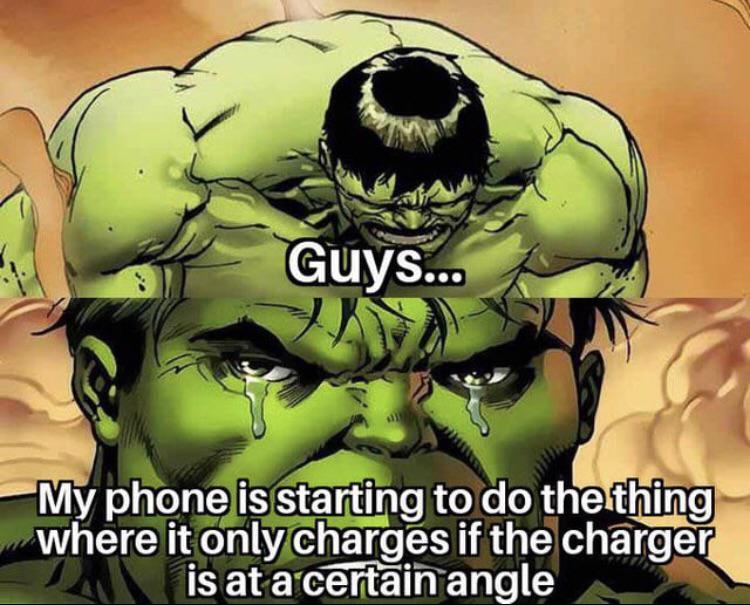this post was submitted on 03 Oct 2024
863 points (97.4% liked)
Funny: Home of the Haha
5767 readers
1202 users here now
Welcome to /c/funny, a place for all your humorous and amusing content.
Looking for mods! Send an application to Stamets!
Our Rules:
-
Keep it civil. We're all people here. Be respectful to one another.
-
No sexism, racism, homophobia, transphobia or any other flavor of bigotry. I should not need to explain this one.
-
Try not to repost anything posted within the past month. Beyond that, go for it. Not everyone is on every site all the time.
Other Communities:
-
/c/TenForward@lemmy.world - Star Trek chat, memes and shitposts
-
/c/Memes@lemmy.world - General memes
founded 1 year ago
MODERATORS
you are viewing a single comment's thread
view the rest of the comments
view the rest of the comments

Wireless charging WILL wear out your battery faster.
For longevity, use a slow wired charger. This will put the least thermal strain on the battery.
How exactly?
Also, my phone charges slower with a wireless charger.
Lots of hand wavy theories and generalizations in the answers below, some of them sound very convincing. None of them actually cite any sources or backup those theories with data.
Here's my own acedotal experience. I've put my phone down on a seemingly well designed wireless charging pad every night for almost 4 years and this phones battery has shown zero sign of deterioration that I can see. This is the first phone I've ever owned with wireless charging and also the first with a battery that hasn't given up the ghost in 2 years or less. The same pad also charges my smart watch every night, which doesn't even have any other option for charging.
Next they'll be telling you to avoid using cruise control on the highway because it will wear out the transmission. Use your phone as it was designed to be used and stop worrying.
Magnetic charging loses some energy in the form of heat on both coils.
Technologies like MagSafe lessen the severity of energy loss via ensuring the coils allign, however there is still some energy lost in the form of heat.
This is just a limitation of electromagnetic induction.
It's a producer of heat placed right next to the battery.
This inefficiency also makes it take more energy to charge your battery. However, I would imagine it's a nominal amount.
That's an interesting theory. I'd like to see some numbers because I really doubt that this heating could be anywhere close to the many other kinds of heat produced through normal phone use. Especially considering that you're unlikely to be stressing the biggest sources of heat in your phone (the screen and the processor) while it's sitting in a wireless charging cradle. Also, the charging circuits certainly monitor and adjust for this kind of heat dissipation specifically and are able to control it far better than, for example, the sun hitting the screen or a warm pocket.
The charging circuit will maintain a "safe" temperature, sure, but using any battery monitor app you like, you can clearly see for yourself that when wireless charging, the phone will sit at a higher temperature during the process, than when wired charging. And every fraction of a degree matters. Not when you use the feature once, but if you do it every day, always charging at a higher temperature, it WILL shorten the lifespan of the battery. The same way every charge does, but to a slightly higher degree for every fraction of a degree in higher temperature.
The battery does not suffer as much damage from heat when discharging, or when just sitting there, not that that is good for it, either. But every extra bit of thermal strain WHILE charging, causes more damage than if it were running cooler. That's simply a fact of lithium ion batteries.
I remember LTT wanting to find out the damage that wireless or fast charging does but found that the way we charge our phones mattered more or something: https://youtu.be/AF2O4l1JprI
I found the segment and may have summarized it incorrectly but I can't rewatch the video entirely right now.
I can only offer you my experience-based evidence, but three magnetic chargers I've used have all made my phone significantly hotter then charging it at the equivalent speed with a cable.
This has been true across 6 Android devices. Two from Google. Four from Samsung. However, I will also say that because of this trend, I stopped using wireless chargers about a year and a half ago, so it's quite possible they might have improved since then.
Yes, the tech has gotten a lot better. 6 phones over about 12 years (rough length of time since debut of inductive charging in smartphones) averages to about 2 years per phone. If you weren't getting the flagship phone each year that lifetime would be shorter. That was comparable to the lifetime of each over my phone's during that same time, none of which had wireless charging. The phone I have now is the first I've had to use inductive charging and it has already lasted twice as long as any of the others and shows now signs of deterioration.
So your anecdotal evidence trumps everyone elses, as well as actual knowledge of the chemistry involved?
I typically use my phones for longer than two years. This included both mine and my wife's devices.